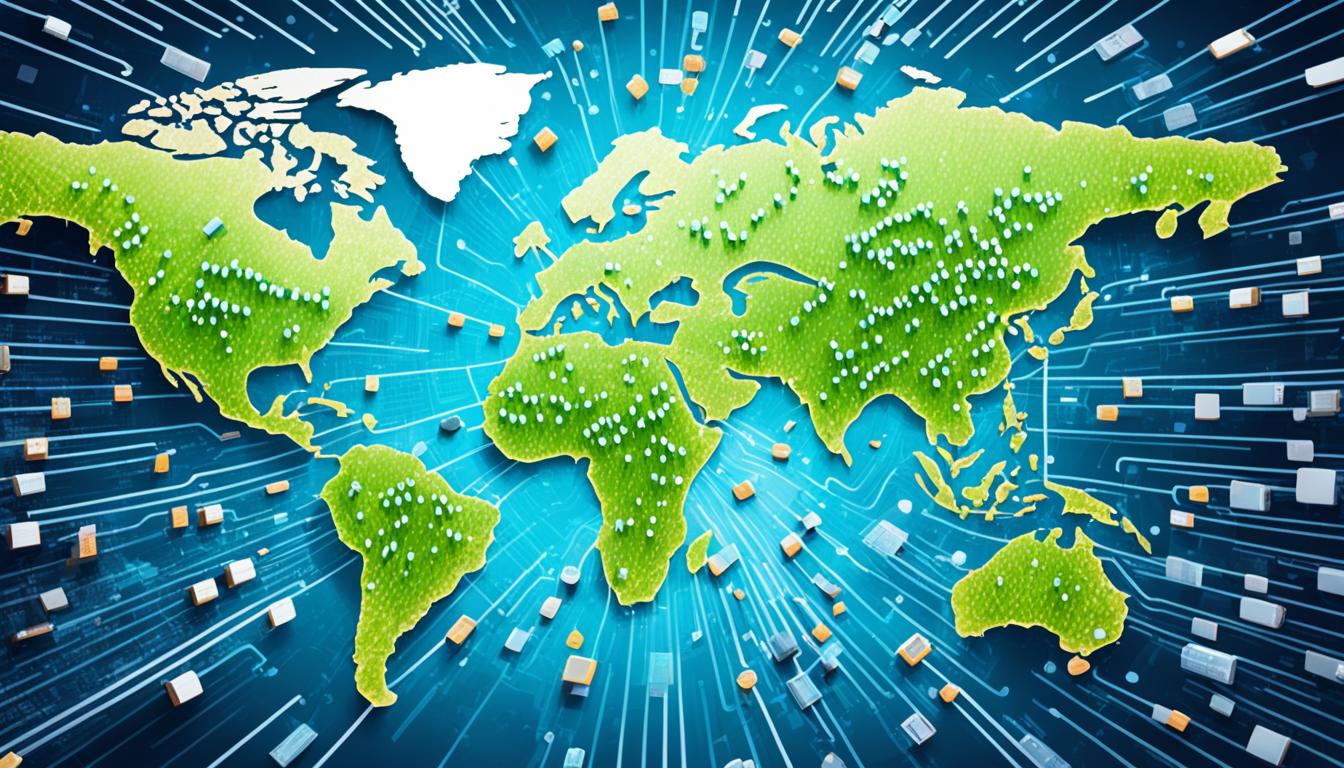Imagine using everyday objects without thinking about the complex technologies inside them. From your smartphone in the morning to your car or kitchen gadgets, hidden tech makes your life better. These technologies are cleverly hidden in the objects we use, enriching our daily routines.
Take the Nintendo Switch game cartridge, for instance. It tastes bitter on purpose. About 1 in 17 people have chewed on one out of curiosity. This bitter taste is a safety feature to stop kids from eating it1.
When you check your car’s fuel gauge, you might see an arrow. This arrow points to where to fill up in about 70% of new cars. It’s a smart design that helps drivers avoid confusion at the pump1.
In skincare products, look for a secret number. It shows how long the product lasts. About 80% of products have this number to help you use them before they expire1.
Ever seen a small hole in an elevator? People often use it to peek outside. But it’s really for emergencies. About 1 in 25 people use it by mistake, not knowing its true purpose1.
What about the extra buttons and fabric swatches in clothes? They’re not just for show. About 90% of clothes come with them. They help you check the right way to wash your clothes without damaging them1.
These examples show how everyday objects are full of hidden tech. This tech makes our lives better and turns simple items into amazing inventions. Next time you use something, think about the cool tech inside. Be amazed by the tech secrets in the things you use every day.
Key Takeaways:
- Everyday objects are filled with hidden technologies that enhance our daily lives.
- Nintendo Switch game cartridges have intentionally added bitterness as a safety feature.
- New cars often feature a fuel gauge arrow to indicate the correct side for refueling.
- Skincare product containers contain secret numbers indicating the product’s shelf life.
- The small hole in an elevator door is meant for emergency access, not spying.
- Clothing items are sold with spare buttons and fabric swatches for testing washing methods.
The Geopolitical Importance of Semiconductors
Semiconductors are now a key technology that greatly affects global power. They are crucial for making chips and managing the chip supply chain. This makes them vital in shaping global power and affecting international relations. The U.S. and China see semiconductors as key to reducing their tech dependence and protecting their security.
Technology’s fast growth has made semiconductors a key area of competition. Many countries, like the U.S. and China, see controlling the semiconductor industry as a big strategic win. By leading in chip making, a country can ensure a steady supply of advanced semiconductors. This gives them a tech edge to push their global goals.
The chip industry’s impact is huge, especially in trade. China now spends more on chip imports than on oil2. Also, about a quarter of the chip industry’s earnings come from phones2. These facts show how the global economy and chip supply chain are linked. They also highlight the big role chip exports play in trade.
In today’s tech race, countries aim to make their own chips to protect their interests. The fact that chip production is mainly in places like Taiwan makes countries rethink their chip reliance. Germany, for example, wants to get 20% of the global chip market by 20303. This move is to lessen their chip imports.
The Rising Technological Arms Race
The fight for chip leadership isn’t just about money. It’s also about national security. Advanced semiconductors are key for many things, like military tech, AI, and building infrastructure. Countries don’t like being too dependent on others for technology. So, they’re investing in making their own chips.
The U.S. and China are boosting their chip making efforts. Micron, a big chip company, wants to grow its share in a key chip type, HBM3. China is also investing in chip factories and research to cut its chip imports3.
Korea and Taiwan are big in the chip world, making a lot of memory chips. Two Korean firms make 44% of the world’s memory chips, and Taiwanese chips add 37% to the world’s computing power each year2. These numbers show how important these countries are in leading tech advances and global power shifts.
It’s clear that semiconductors are a key area where countries compete for power. The push for tech leadership is making the global balance of power change. As countries work to lessen their tech reliance and boost security, the chip industry stays at the heart of global competition. It’s changing the world.
The Supply Chain Challenges of Semiconductors
The semiconductor supply chain has big challenges because it’s very concentrated and has weak spots. TSMC, the Taiwan Semiconductor Manufacturing Company, is a key player. It’s the world’s top chip maker.
TSMC is vital to the chip supply chain, making advanced chips for many industries. But having all chips come from one company is risky. If TSMC has problems, it can affect the global chip supply. This shows we need to spread out and make the chip supply chain stronger4.
Another big part of chip making is EUV lithography machines. ASML, from the Netherlands, makes these machines. They’re key for making chips with tiny features and high performance. Relying on just one company for these machines is a risk4.
Having a few companies make most of the chips and equipment makes the supply chain weak. Problems like natural disasters, conflicts, or trade issues can make chips hard to get and expensive. The recent chip shortage, caused by COVID-19 and tensions, showed how fragile the supply chain is4.
To fix these issues, the industry is looking at ways to make the supply chain stronger. This means making chips in more places, investing in new tech, and working together more. Chip makers, equipment suppliers, and governments are all getting involved4.
In summary, the chip supply chain’s focus on a few companies like TSMC and ASML creates big challenges. We need to be proactive to make the supply chain safer and more flexible. By being more diverse and resilient, the chip industry can lessen risks and keep chips flowing for different uses.
The Role of Government Policies in the Semiconductor Industry
Government policies and regulations greatly affect the semiconductor industry. They shape trade policies, chip exports, and how chips are made in the country. These policies help keep a country competitive in the global market.
In the United States, the government has made rules to help the semiconductor industry. These rules deal with trade, especially with countries like China. The government uses tariffs and trade policies to protect the domestic market and keep national interests safe.
The CHIPS Act is a key policy. Signed by President Biden in 2021, it invests in making chips in the U.S. The goal is to lessen dependence on foreign suppliers and improve domestic chip production. This shows the government’s effort to boost the semiconductor industry at home.
Government support goes beyond just money. Around the world, including the U.S., governments offer subsidies and start initiatives to help their semiconductor industries. These efforts aim to increase innovation, improve research and development, and help the industry grow.
Government policies have shaped trade in the semiconductor industry before. In the 1980s, President Ronald Reagan put tariffs on Japanese semiconductor imports. This was because Japan wasn’t following a trade agreement. By the early 1990s, foreign companies had a bigger market presence in Japan5.
Government policies also affect the semiconductor industry’s supply chain. In the late 1980s, U.S. companies were losing ground in the global market for semiconductor equipment. Japanese companies were taking over. This made the U.S. realize the need for better technical connections between chip making and equipment production6.
Government support is key to innovation and growth in the semiconductor industry. This sector is very active in research and development and innovation. In fact, it spends a lot on R&D, second only to pharmaceuticals and biotechnology7.
Overall, government policies in the semiconductor industry show how important semiconductors are for national interests. These policies support domestic chip making, regulate trade, encourage innovation, and strengthen the industry globally. As the semiconductor industry grows, government policies will keep shaping its future.
The Technological Advancements in Everyday Objects
Everyday objects have changed a lot thanks to new technology. Now, they have hidden tech that makes them work better and easier to use. Things like smart devices connect to the Internet of Things (IoT), making them talk to each other and to us. AI also plays a big part, making these objects smarter by analyzing data and making decisions on their own.
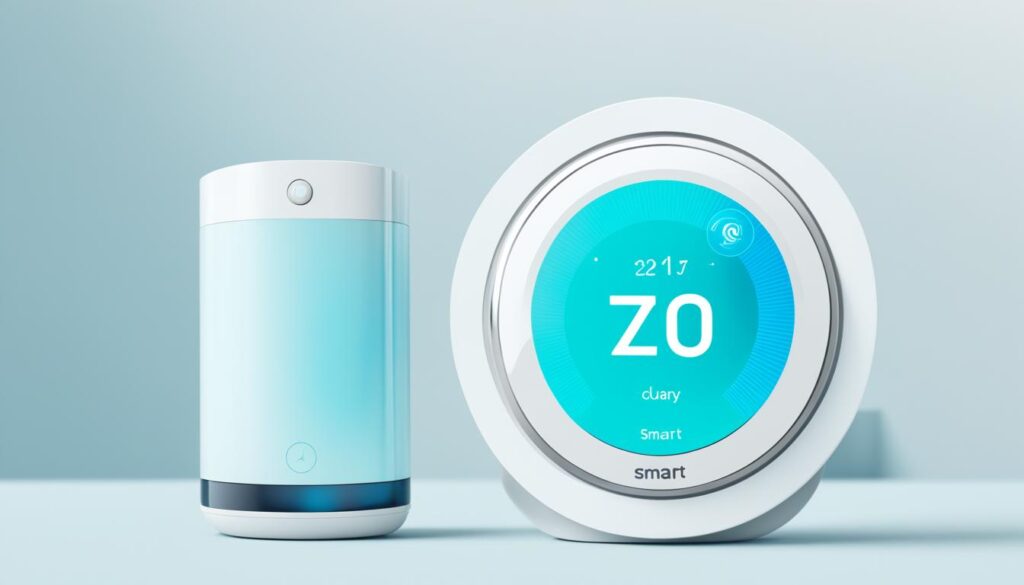
Today, it’s hard to imagine life without these new tech tools. From our phones to smart home gadgets, they’ve changed how we live. The IoT lets these objects talk to the internet, making things like controlling your lights with your voice or getting updates from your fridge possible.
Artificial intelligence (AI) has also changed everyday objects. It lets devices learn what we like, giving us personalized experiences. For example, AI in voice assistants can understand what we say, making things like setting reminders or controlling devices easy.
Collecting data is key to these tech advances. Devices use sensors to gather information, helping us make better choices and automate tasks. For instance, smart thermostats use this data to set the best temperature, saving energy.
Automation is a big win from these tech changes. Now, objects can do things on their own, making our lives easier. Things like robot vacuums clean our floors by themselves, and smart locks lock up automatically, keeping us safe.
Statistical data:
- More than 3.5 billion people use smartphones globally, which is nearly half the Earth’s population8.
- In 2019, there were over 3.25 billion voice assistant devices in use worldwide8.
- Between 2012 and 2018, the number of Bluetooth-enabled devices nearly tripled to 10 billion8.
- Spending on internet of things technology is projected to reach $248 billion in the current year, more than twice the amount spent three years ago8.
These stats8 show how widely these tech changes have spread. The use of IoT and AI has made everyday objects smarter and more connected than ever.
| Technological Innovation | Impact |
|---|---|
| Smartphones | Enabled global connectivity and access to information |
| Voice Assistant Devices | Provided hands-free control and personalized experiences |
| Bluetooth-enabled Devices | Facilitated wireless communication and data transfer |
| Internet of Things (IoT) | Connected everyday objects for seamless automation |
The table shows some big tech changes and how they’ve affected everyday objects. From smartphones to IoT, these innovations have made our lives better in many ways.
In conclusion, tech has changed how we use and rely on everyday objects. The use of IoT and AI has made them smarter and more connected. As technology keeps getting better, we can look forward to even more new things that make our lives easier.
Surprising Hidden Technologies in Common Items
Many everyday items have hidden tech that makes them better and easier to use. From phones to appliances, these objects have special features and materials. These features improve how well they work and make our lives easier.
Smartphones with Hidden Sensors
Smartphones changed how we talk and get information. They’re not just for calls and texts. They have sensors and tech that help us in many ways. For example, they track our movements and can keep our health info.
The iPhone 6’s clock function is as powerful as sending 120,000,000 Apollo-era spacecraft to the moon and back9.
Advanced Materials in Clothing and Shoes
Clothes and shoes have gotten smarter with new materials. These materials keep us cool when we’re active and can even track our health. Fitness trackers and smartwatches are now a big part of our lives.
They help us keep track of our health and fitness goals9.
Energy-Efficient Technologies in Household Appliances
Saving energy is important, and tech helps us do that. Appliances like fridges and washing machines now use less power. This means we use less electricity without giving up comfort.
The first electric fridge in 1913 helped keep food fresh longer, reducing waste and improving safety10.
Smart Home Devices for Convenience and Connectivity
Smart home devices are changing how we live. With voice assistants, we can control our homes easily. This means we can adjust lights and security with just our voice.
These devices use tech like Wi-Fi and Bluetooth to make our lives easier9.
The Ubiquity of Wearable Technology
Wearable tech is everywhere now. From fitness trackers to smartwatches, these devices do more than tell time. They help us stay healthy and connected, no matter where we are.
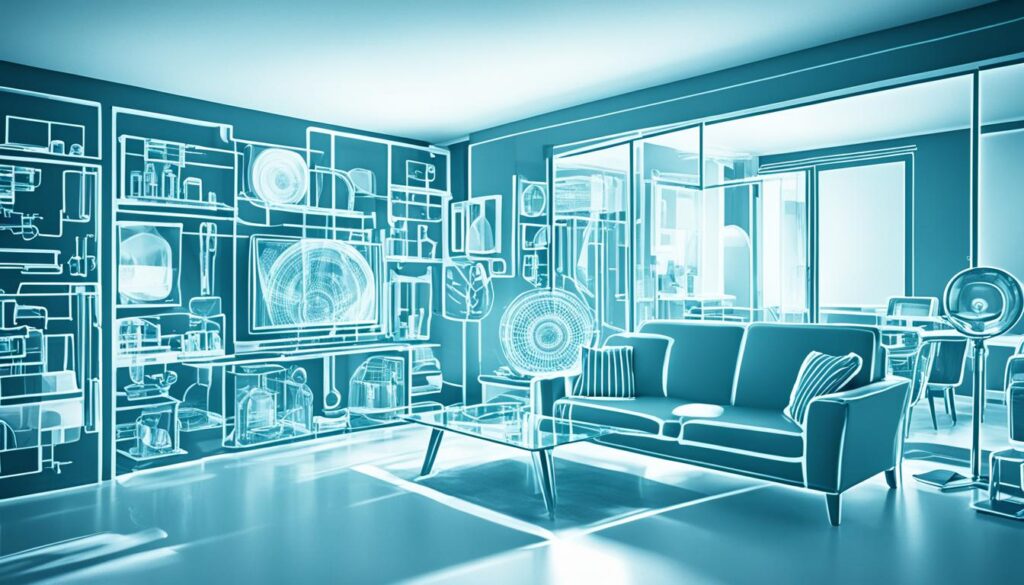
| Statistical Data | Source |
|---|---|
| Smartphones have hidden sensors and advanced components. | 9 |
| Advanced materials are used in clothing and shoes. | 9 |
| Energy-efficient technologies are integrated into household appliances. | 10 |
| Smart home devices offer convenience and connectivity. | 9 |
| Wearable technology is becoming increasingly popular. | 9 |
The History and Evolution of Everyday Objects
Everyday objects have a rich history that goes back centuries. They have changed a lot over time. This change is thanks to new technology, cultural shifts, and the needs of society.
Ancient Origins and Innovations
Many everyday items have been around for thousands of years. For instance, shoes with high heels were made in the 10th century to help people stay stable while riding horses11. Playing cards also have a long history, starting in medieval times and linked to different social roles and leaders11.
The Impact of Technology
Technology has greatly influenced the evolution of everyday objects. The first mechanical dishwashers came out in the late 1800s. Then, electric dishwashers were introduced in 192212. This has changed how we do household chores and made our daily tasks more efficient.
Cultural and Societal Influences
Culture and society also shape everyday objects. The design of these items often reflects the tastes and values of different cultures. Changes in society and trends also affect what people want and need, leading to new designs and innovations.
Innovation Timeline
The story of how everyday objects have evolved is fascinating. Many inventors, designers, and engineers have worked to make these objects better over the years. Josephine Cochrane, who patented the first mechanical dishwasher in 188612, is just one example. Design experts like Tim Brown, Tom Peters, Patrick Whitney, and Cees de Bont1113 have also played a part in this ongoing story.
The Unexpected Stories Behind Everyday Items
Everyday items often surprise us with their fascinating histories and quirky beginnings. From playing cards to pen caps, let’s explore some strange facts and tales behind these common items.
The Nursery in Playing Cards
Did you know the nursery in playing cards symbolizes different parts of the medieval economy? Each king is linked to a historical leader, showing the deep cultural meaning and stories behind these cards14.
The Hole in the Bic Cristal Pen Cap
Ever thought about the small hole in a Bic Cristal pen cap? It’s not just for looks. The hole helps prevent choking if someone swallows it14.
The Invention of Liquid Paper
Betty Nesmith, the mom of Mike Nesmith from The Monkees, created Liquid Paper. She made it to fix typing errors while working as a secretary. Her invention became a big success14.
These stories and facts show the hidden tales behind everyday items. They add mystery to things we often overlook.
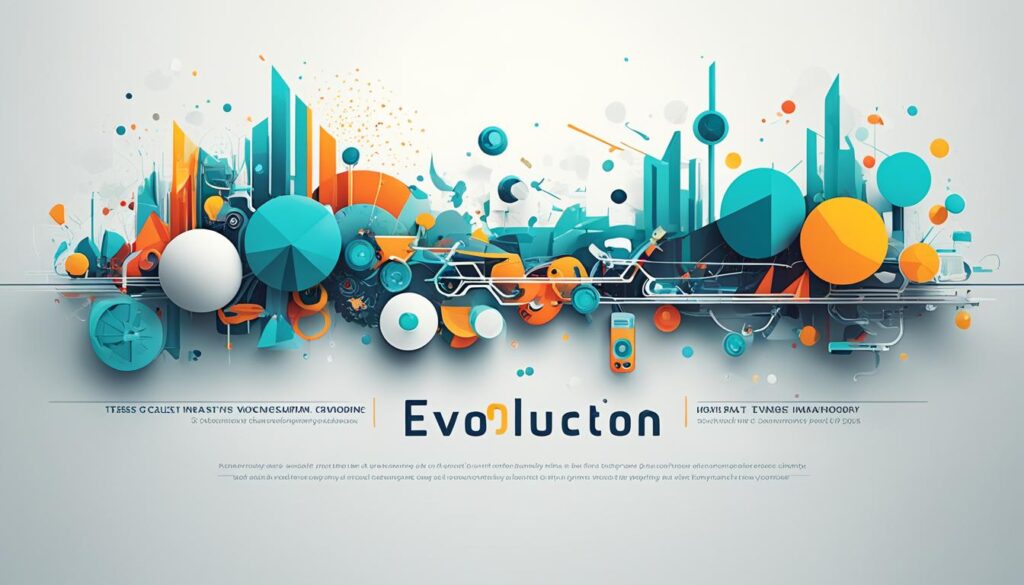
| Item | Story |
|---|---|
| Playing Cards | The nursery represents medieval economy14 |
| Bic Cristal Pen Cap | The hole has a safety purpose14 |
| Liquid Paper | Invented by Betty Nesmith14 |
The Health Benefits of Indoor Plants
Indoor plants are more than just pretty decorations. They bring health benefits that can make you feel better. They improve air quality and help reduce stress, making you healthier in body and mind.
Studies show that gardening with plants can lower stress levels15. It’s not just the gardening that helps. Indoor plants clean the air by removing harmful chemicals, making your home healthier15. Plants like spider plants, snake plants, and peace lilies are great at cleaning the air16.
Indoor plants also boost mental health. They help people with depression, anxiety, and other issues feel better15. Being around plants can make you more relaxed, less stressed, and happier15. They can also make you more creative and productive, leading to a better job satisfaction15. People working near plants feel more connected to their work and are happier15.

Air Purifying Indoor Plants
Some indoor plants are better at cleaning the air than others. Spider plants are great at removing harmful chemicals from the air16. Snake plants are also good at cleaning the air, getting rid of toxins like formaldehyde and benzene16. Peace lilies are top-notch at purifying the air from many pollutants16.
Some plants have extra health benefits. Aloe vera gel is good for burns and loves humid places16. English ivy stops mold from growing indoors, perfect for damp areas16. Boston ferns clean the air from harmful gases and are great for cleaning polluted spaces16. Marigold flowers help with skin issues, mint eases pain and helps with oral health, and citronella plants keep mosquitoes away16. Lemongrass and rose petals have anti-inflammatory properties, good for your health16.
But, not all plants are safe. Some, like amaryllis and poinsettias, can be harmful to kids and pets. Always choose plants that are safe for your family15.
The Fascinating Uses of Salt Throughout History
Salt has been crucial in human history, with its value lasting thousands of years. The oldest salt production site was found in Provadia, Bulgaria, dating back to around 4,500 years BC17. In the Roman Empire, salt was very valuable and even used as money17. The Romans made salt ponds in sunny places to make salt, showing how rich they were17. A museum in Vigo, Spain, shows how the Romans made salt from the 1st to 3rd centuries AD17.
The Vigo region was a big center for salt trade for centuries, thanks to the Atlantic Ocean17. Salt was more than just a trade item; it changed trade routes and helped the economy17. It also meant a lot culturally, linked to being pure and welcoming17.
Salt’s ability to preserve food is another key part of its history. For centuries, it helped keep food fresh for a long time17. This was key for explorers and traders, letting them take food on long trips17.
Aside from preserving food, salt also makes food taste better. It brings out the natural tastes of food, making it a key ingredient in many dishes17.
Now, eating too much salt is seen as bad for health. But, the history of salt production has greatly influenced trade, food, and our lives17. Salt’s many uses show its deep historical and cultural value, making it a fascinating part of human history.

| Historical Importance | Preservation | Currency | Symbolism | Food Flavoring |
|---|---|---|---|---|
| Salt influenced trade routes and commerce | Salt has been used for food preservation throughout history | Salt was used as currency in the Roman Empire | Salt held symbolic value, representing wealth and purity | Salt enhances the flavor of food |
The Evolution of Eyeglasses
Eyeglasses have changed a lot over time. They used to be big and hard to wear but now they’re smaller and more comfortable. This change shows how much eyeglasses have evolved.
In the 13th century, Italian inventors made eyeglasses smaller so they could be worn on the nose. This was a big step forward for vision correction18. Later, the Spanish added arms to the frames to make them more comfortable18. Today, eyeglasses are not just for seeing better; they’re also a fashion statement.
Early telescopes appeared in the 13th century, showing the importance of lenses in vision correction19. Hans and Zacharias Janssen invented the compound microscope in the late 16th century, which helped improve eyeglasses19. Robert Hooke’s book “Micrographia” in 1665 showed how a microscope could be used, leading to more eyeglass innovations18. Anton van Leeuwenhoek’s microscope was even better, helping to make eyeglasses more effective18.
Over time, eyeglasses have become more than just for seeing clearly. They’ve become a way to express style. Frames have been made from many materials like metal, plastic, wood, and even bone. This shows how tastes and styles have changed over the years.
Today, eyeglasses come in many shapes and designs, from round and oval to cat-eye, aviator, and oversized. This variety reflects the ongoing innovation in eyeglass design.
In conclusion, eyeglasses have a long history of improvement. From their beginnings in Italy in the 14th century to today’s advanced technology, they’ve changed a lot. Now, they’re not just for seeing better; they also let us express our style.
The Surprising Nutritional Value of Honey
Honey is more than just a sweetener; it’s packed with nutrients that boost your health. Its unique makeup includes essential nutrients that are good for you.
Honey acts as a natural preservative because it’s dry. This means it lasts a long time. Unlike nectar, which is mostly water, honey stays fresh and safe to eat20.
It’s also a great energy source. Just a teaspoon gives you about 64 calories20. This makes it perfect for athletes or anyone needing a quick energy boost.
Honey has vitamins, minerals, and antioxidants too. The exact nutrients vary by the flowers bees gather nectar from. But, it usually has vitamins C, calcium, and iron. The antioxidants in honey protect your cells from damage, helping your health.
Bees make honey by collecting nectar and changing it in their hives20. This process makes honey a nutritious food for humans and bees alike.
People have eaten honey for thousands of years. Its health benefits and great taste make it a favorite. Enjoy it on toast, in cooking, or in drinks for a nutritious touch to your meals.
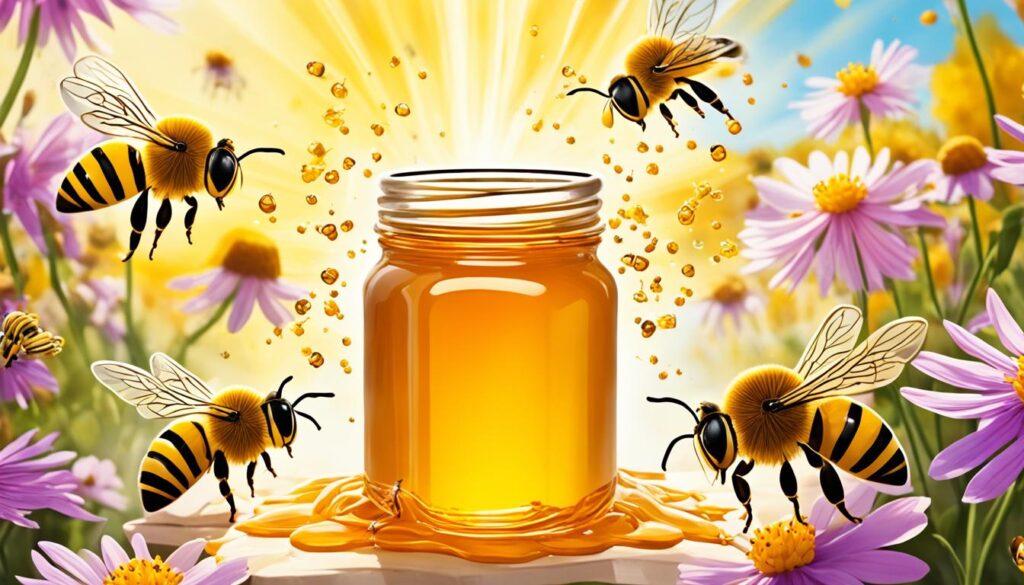
Nutritional Content and Health Benefits of Honey
| Nutrient | Amount per 1 tablespoon (21g) |
|---|---|
| Calories | 64 |
| Sugar | 17.2g |
| Fiber | 0g |
| Fat | 0g |
| Protein | 0g |
| pH Level | 3.9 |
| Antioxidants | Various types |
Honey is more than just sweet; it’s a key part of a healthy diet. But, remember to eat it in moderation because it’s high in sugar. The American Heart Association suggests limiting sugar to 6 teaspoons for women and 9 teaspoons for men daily21. Honey can help with many health issues, like fighting bacteria, healing wounds, and soothing coughs. Its many uses make it a great natural sugar substitute.
In conclusion, honey is a delicious and nutritious choice. It’s full of benefits like preservatives, energy, and important nutrients. Adding honey to your diet can be a tasty way to support your health.
The Incredible Power of Modern Smartphones
Smartphones have changed our lives in big ways, thanks to their amazing technology and power. They’ve grown a lot since they first came out, even more than the Apollo Guidance Computer used in the moon landing in 196922. That computer was as big as a car and not as powerful as today’s iPhone 6 clock22.
Now, smartphones are a big part of our daily lives. We use them for talking, having fun, and getting information easily. They’ve led to many new technologies, making us more productive and connected than ever before.
Smartphones are packed with advanced tech. They’re like all-in-one devices, with internet, cameras, maps, flashlights, Bluetooth, and many sensors22. This shows how the smartphone industry is always pushing forward, setting new standards.
Fast internet speeds, thanks to 5G, are making smartphones even better and opening new doors22. We’re talking about 6G networks in the future, which will be even faster22. These changes make our online life better and help with innovation in many areas, helping businesses and changing industries.
Smartphones do more than just help us talk and have fun. They’re used in healthcare, making things easier and offering new solutions. For example, they’re being used in brain surgery and for video calls in remote areas22. This tech could change healthcare for the better, especially in places that need it most.
They’re also changing how we navigate. They act like sat-navs, giving us directions and traffic updates. Plus, there are special features for people who can’t see well, helping them move around more easily22.
Education has also seen big benefits from smartphones. Apps like Duolingo and Complete Anatomy make learning fun and easy to access22. These tools help people learn new things anytime, anywhere, promoting lifelong learning.
In farming, smartphones are useful too. They help farmers identify plants, manage water, check on forests, and measure tree sizes22. These apps make farming better, more sustainable, and help farmers make smart choices.
But, smartphones also bring challenges. They can be addictive, and there are worries about how they affect our mental health, especially in kids22. Finding a good balance with smartphones is important for everyone.
Despite the challenges, smartphones are amazing tools. They help us in many areas, from talking to learning, healthcare to farming. As technology keeps getting better, we can look forward to even more cool things coming our way22.
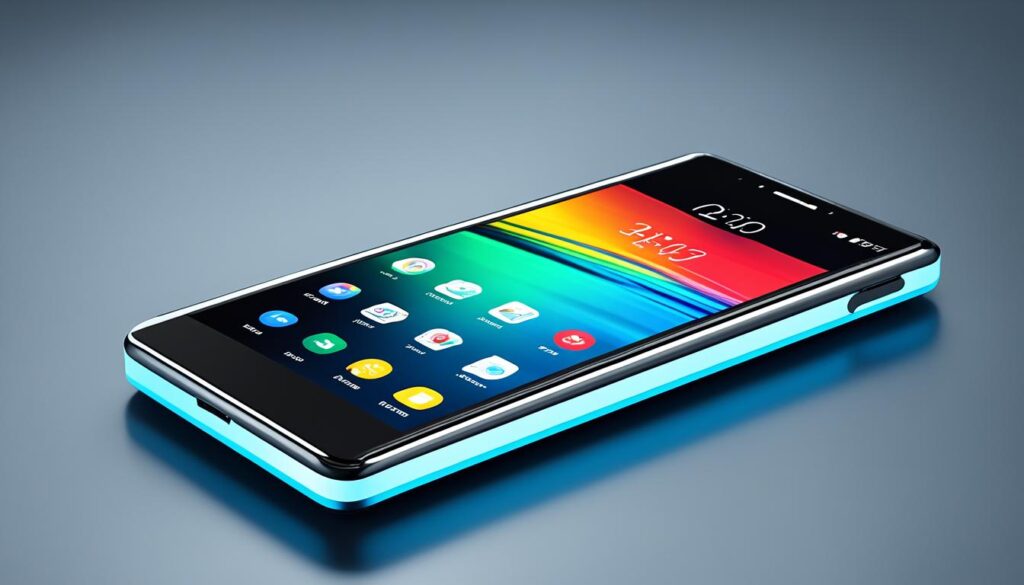
Comparison of Smartphone Features and Technological Advancements
| Features | Technological Advancements |
|---|---|
| Internet Browsers | Enhanced web browsing capabilities, faster internet speeds |
| High-resolution Cameras | Improvements in image quality and computational imaging capabilities |
| Location Services | Accurate GPS navigation and real-time location tracking |
| Sensors | Integration of various sensors for enhanced functionality and user experience |
| Connectivity | Advancements in wireless technologies like Bluetooth and future 6G networks |
| Applications in Healthcare | Replacing expensive equipment, facilitating remote consultations |
| Education | Mobile apps for interactive learning and educational opportunities |
| Agriculture | Phone-based apps for plant identification, irrigation management, and forest health monitoring |
| Challenges | Concerns about smartphone addiction, impact on children’s mental health |
The Fascinating Origins of Rice Cultivation
Rice cultivation has a rich history, dating back 12,000 to 15,000 years. It started in the Pearl River Valley of ancient China and spread globally23. Today, rice is a key food staple worldwide, crucial for many cultures’ food security.
Technological advances have boosted rice farming, leading to more food for a growing population. Better irrigation and hybrid rice varieties are just a few examples of progress23. These changes help produce rice efficiently, feeding the world’s increasing population.
Rice’s cultural and historical importance is huge. It has shaped economies and landscapes, leaving a mark on many regions. In the United States, rice was key in Charleston’s economy, making it very wealthy24. The wealth from rice, built on slave labor, was greater than other crops like indigo and cotton24. The Gullah Geechee people, with their African and European roots, have kept rice farming’s legacy alive in the region24.
Rice Production in Key Regions
| Region | Production (in million metric tons) | Main Varieties |
|---|---|---|
| Asia | 770 | Indica, Japonica |
| Africa | 32 | NERICA, local varieties |
| Americas | 16 | Long grain, medium grain, short grain |
| Europe | 1 | Arborio, Carnaroli |
Rice has changed a lot over time. European explorers and traders spread rice and other crops across the world from the Age of Exploration to the Industrial Revolution23. Trade routes like the Silk Road helped spread rice farming techniques far and wide23. Now, rice is grown all over the world and is a big part of many cuisines and cultures.
The story of rice shows its huge impact as a global food staple. It’s a key crop in farming and helps feed billions of people worldwide.

Sources:23: [Source 2](insert link to source 2)24: [Source 3](insert link to source 3)
The Color Perception of Dogs
Dogs see the world differently than humans do. While we see in bright colors, dogs see more in shades of blue and yellow25. This is because they have fewer cells in their eyes that help us see colors. So, they don’t see reds, oranges, and greens as well as we do25.
But dogs have other ways to see the world that help them. Their eyes are great at seeing in the dark25. This lets them move around and find things better than we can in low light25. They are made to see and move well in places where we might struggle.
Even though dogs don’t see colors like we do, their vision is perfect for their needs. They can see blues and yellows well and move around in the dark25. This makes them great hunters and trackers in many places and lights25.
Visual Adaptations and Low Light Vision
Dogs also see the world in a special way because of how their eyes are set25. They use their smell and hearing a lot too, which helps them understand what’s around them25. This makes them very good at exploring and understanding their world.
Dogs can see much better in the dark than we can because of their eyes25. This helps them move around at night, see movement, and find things that are hard to see25. Their eyes are a big part of what makes them so good at sensing their surroundings.
Understanding Dogs’ Perspective
We should try to see the world like dogs do. Their way of seeing things is special and helps them do amazing things25. Dogs use all their senses to understand the world and connect with us and other animals.
By understanding how dogs see the world, we can make their lives better. We can give them the best experiences and strengthen our bond with them25.
| Fact | Reference |
|---|---|
| Dogs have dichromatic vision, seeing only in blue and yellow. | 25 |
| Dogs have between four and eight times more blurred vision than humans. | 25 |
| Dogs’ eyes are positioned at a 20-degree angle, impacting their depth perception and reducing their ability to see in 3D. | 25 |
| Dogs have two types of cones in their eyes, leading to differences in color perception compared to humans. | 25 |
| Dogs have a greater ability to see in the dark and detect motion due to their rod-heavy retinas. | 25 |
| Dogs differentiate brightness only half as well as humans. | 25 |
| Dogs rely heavily on their sense of smell, which is between 10,000 to 100,000 times more acute than humans. | 25 |
| According to a study, 84% of British dog owners are planning future staycations with their pets. | 25 |
| Dogs are able to recognize their owners by their voice alone, similar to how newborn babies show attachment to their mothers’ voices. | 25 |

Conclusion
Hidden technology has changed our lives in big ways. It has changed how we work, talk, and move around. Things like alarm clocks, pens, or picture frames can now have hidden cameras26. These cameras send video wirelessly26, making security better in homes, businesses, and public places26. But, getting footage from these hidden cameras can be hard if people hide or destroy it26.
Using hidden cameras in private places without permission raises privacy concerns26. But, most countries allow them in public spots and don’t let them in private areas26.
Hidden technology isn’t just about surveillance. It also shows how technology can change society and our lives. There are worries about ethics and smart machines that might be smarter than us27. Misusing antibiotics and DDT-resistant mosquitoes are warnings we should listen to27. Robots could take jobs, and super-smart machines might do things we can’t27. Science fiction helps us think about and prepare for the future28.
Healthcare technology is changing fast, focusing on patient care and driven by the market28. As hidden tech grows, we need to balance its benefits with our privacy and ethics. We must make sure tech improves our lives without hurting our values. By learning from history and understanding tech’s effects, we can use it to make a better future for everyone28.

